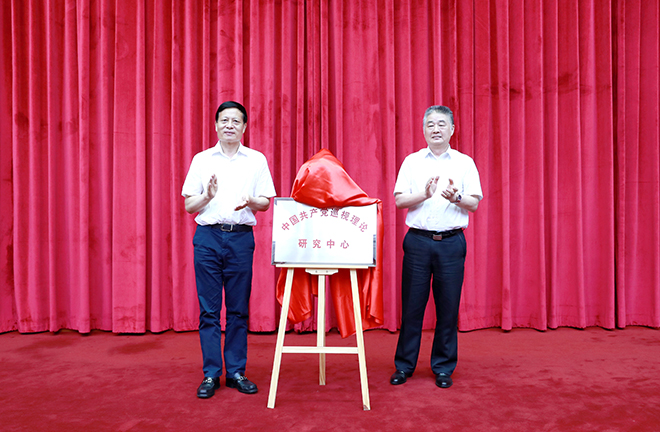Center of CPC’s inspection theory unveiled

Xie Fuzhan (Left) and Yang Xiaoshan (Right) unveil the center of CPC’s inspection theory on July 10. Photo: Zhu Gaolei/CSST
The center of CPC’s inspection theory was unveiled on July 10, by Xie Fuzhan, president of the Chinese Academy of Social Sciences (CASS), and Yang Xiaoshan, head of the Discipline Inspection Group sent to CASS by the CPC Central Commission for Discipline Inspection and the National Supervisory Commission.
The center was established in June to focus on major theoretical and practical issues concerning inspection, effectively integrating the academic resources and research capabilities of CASS and related units to carry out high-quality research.
As a vivid practice and concrete manifestation of the CPC’s self-reform, also as an important means of internal oversight, the inspection system has written an important chapter in the history of the century-old party, Xie said.
Since the 18th CPC National Congress in 2012, the CPC Central Committee with Comrade Xi Jinping at the core has elevated inspection to a more prominent position, and has included inspection in the overall framework of “practicing strict self-governance in every respect,” as a strategic institutional arrangement for strengthening intraparty oversight.
The Chinese inspection system has a profound historical and cultural inheritance, and rich theoretical and practical experience. Bu Xianqun, director of the Institute of Ancient History at CASS, said that inspection and supervision began during the Warring States Period (475–221 BCE) and the Qin Dynasty (221–206 BCE), and formally took shape in the cishi (inspector) system implemented by Emperor Wu (r. 141–87 BCE) of the Western Han Dynasty.
“The history of inspection and supervision has left us both valuable experience and profound lessons,” Bu said. It is noteworthy that under different historical, social, and political conditions, as well as instances of corruption, the inspection system and the supervised content were bound to vary.
The CPC has focused on the inspection system since its establishment. In July 1922, the CPC Constitution adopted by the Second CPC National Congress proposed initiating special commissioners assigned by the central committee to guide work in localities. The Party’s inspection system began to develop, which was further improved after the PRC’s founding in 1949.
In the Party’s regulation system, the establishment and development of the inspection system has come a long way. Among the improvements, the CPC’s Regulations on Inspection Work, promulgated in 2015 and revised in 2017, laid the foundation.
Inspection practices have accumulated much successful experience. However, as circumstances and practical needs change, there are also new challenges and tasks. Ma Huaide, president of China University of Political Science and Law, noted that the CPC’s Regulations on Inspection Work should be revised again, in due course.
Cai Zhiqiang, deputy Party secretary at the China Academy of Discipline Inspection and Supervision, said that inspection is both top-down from authorities, and also bottom-up, since its power is granted by the people. The inspection system embodies and maintains the principal status of the people, while strengthening the centralized and unified leadership of the CPC Central Committee.
“It is a clear and scientific institutional arrangement and supervision process,” Cai said.
Edited by JIANG HONG

 PRINT
PRINT CLOSE
CLOSE